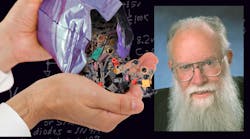This article is part of Bob Pease's Floobydust series found in the Electronic History section of our Series Library.
People keep asking me when they will get to see my latest Dead Car List, where I keep track of all the disabled and abandoned cars I see on the road. Alas, while I have a couple of grocery bags of raw data on dead cars, I have not been able to find time or priority to organize them into a list. I’ve been too busy for 15 years, writing columns and other technical stuff.
Here’s the real problem. Cars now just about all look the same. It used to be that I could tell the difference between a Ford, Chevy, VW, Saab, or Peugeot from three or four lanes away, even at night, even in the rain. That was 30 years ago.
These days, the boxes mostly look the same. The jellybeans look about the same. The SUVs look about the same. The nameplate on the trunk lid is usually unreadable at 60 mph. Also, cars are not as unreliable as they used to be. So, any data is not gonna be significant. Sigh. I’ll still keep any data I get, but it’s not as significant as it used to be.
TAXY Several years ago, one of my correspondents told me (repeatedly) that a certain amount of taxable income plus some Social Security income would take you to a place where every dollar you earned would cause 85 cents of income tax. This is not done in any tax table, but in the Social Security Benefits Worksheet. I published this statement back in the April 10, 2007 issue (“What’s All This AMT Stuff, Anyhow?” ).Several readers were very skeptical. So, I asked my correspondent at exactly what incomes this 85% rate would happen. My correspondent denied ever telling me what he had told me four times. So I must, sadly, retract my statement of the “85% tax rate.” I apologize for my error. Apocryphal. Meanwhile, I have never taken any Social Security income. If I’m lucky, I never will.
NEW BOOK I recently finished editing a book, Analog Circuits—World Class Design. You can look it up on the Barnes & Noble Web site at www.bn.com or on Amazon.com. It has 18 excellent chapters by eight very good authors. Take a peek.CHRISTMAS TREE LIGHTS Howard Frank told me about his tool for fixing dead Christmas tree lights, per “What’s All This ‘Others Stay Lighted’ Stuff, Anyhow?” It’s called the Lightkeeper Pro, and it can be found at LightkeeperPro.com. It has two good tools for finding the dead bulb and fixing it up (Fig. 1).Martin thought I had bad numbers for the mV per decade, and he was correct. I’d said it was 60 mV per decade at 27°, and it is really 59.5264. I was off by +0.8%. My general analysis and approach was pretty good, but I was using the wrong numbers.
For a quick and dirty approximation, 60 mV per decade at room temperature is a pretty good rough rule of thumb, with 80 mV when hot at 127°C and 40 mV at –73°C. But the accurate value of kT/q at 300 Kelvin is 25.582 mV, as the value of Boltzmann’s Constant is quite precisely known, as is the charge of the electron. And it’s 59.5264 mV per decade, not 60.
So, I’ll have to rework that text and the drawings. I’m sorry! Thanks for hollering, Martin! He was the first reader to catch that error.
Read What's All This Floobydust Stuff, Anyhow? (Part 6)
Comments invited! rap@galaxy.nsc.com —or:
Mail Stop D2597A,National Semiconductor
P.O. Box 58090, Santa Clara, CA 95052-8090
Bob Pease obtained a BSEE from MIT in 1961 and is Staff Scientist at National Semiconductor Corp., Santa Clara, Calif.


